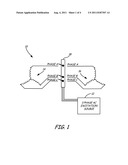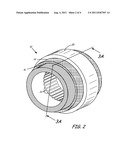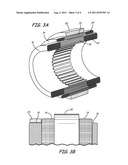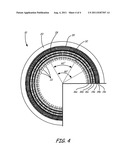Patent application title: MULTI-SPEED INDUCTION MOTOR
Inventors:
Joseph Kenneth Coldwate (Roscoe, IL, US)
Joseph Kenneth Coldwate (Roscoe, IL, US)
Assignees:
HAMILTON SUNDSTRAND CORPORATION
IPC8 Class: AH02P2520FI
USPC Class:
318777
Class name: Plural speed pole changing separate primary running winding for each pole number, alternately energized
Publication date: 2011-08-04
Patent application number: 20110187307
Abstract:
A multi-speed induction motor includes at least two stator windings (a
low pole count winding and a high pole count winding) wound around a
common stator core. A plurality of stator teeth extend radially inward
from a stator yoke, thereby defining a plurality of slots open to its
inner diameter. The high pole count winding is wound around the stator
core first, such that the high pole count winding is located adjacent to
the stator yoke. The low pole count winding is wound subsequently, such
that it is radially interior to the high-pole count winding.Claims:
1. A multi-speed induction motor comprising: a stator portion having a
stator yoke and a plurality of stator teeth extending from the stator
yoke, the plurality of stator teeth defining a plurality of slots open to
its interior diameter; a high pole count stator winding wound through the
slots defined by the plurality of stator teeth and located adjacent to
the stator yoke; and a low pole count stator winding wound though the
slots defined by the plurality of stator teeth and located radially
interior to the high pole count stator winding.
2. The multi-speed induction motor of claim 1, the high pole count stator winding including endturns spanning a first number of stator teeth.
3. The multi-speed induction motor of claim 2, the low pole count stator winding including endturns spanning a second number of stator teeth greater than the first number of stator teeth.
4. The multi-speed induction motor of claim 3, wherein the endturns of the low pole count stator winding are radially interior to the endturns of the high pole count stator winding.
5. The multi-speed induction motor of claim 1, further including: an insulative layer located between the high pole count stator winding and the low pole count stator winding.
6. The multi-speed induction motor of claim 1, wherein the outer circumference of the low pole count stator winding is less than the outer circumference of the high pole count stator winding, and the axial length of the low pole count stator winding is greater than the axial length of the high pole count stator winding.
7. The multi-speed induction motor of claim 6, wherein an annular space provided by the differences in respective circumferences and axial lengths of the low pole count stator winding and high pole count stator winding is utilized to make terminal connections for both the stator windings.
8. A two-speed induction motor comprising: a stator portion having a stator yoke and a plurality of stator teeth extending from the stator core, the plurality of stator teeth defining a plurality of slots open to its interior diameter; an interior rotor portion axially aligned with the stator portion; a high pole count stator winding wound around the plurality of stator teeth and located adjacent to the stator yoke, the high pole count stator winding having a plurality of endturns that span a first number of stator teeth; a low pole count stator winding wound around the plurality of stator teeth and located radially interior to the high pole count stator winding, the low pole count stator winding having a plurality of endturns that span a second number of stator teeth greater than the first number of stator teeth; and a switching relay connected to selectively distribute alternating current to either the high pole count stator winding or the low pole count stator winding.
9. The multi-speed induction motor of claim 8, wherein the endturns of the low pole count stator winding are radially interior to the endturns of the high pole count stator winding.
10. The multi-speed induction motor of claim 8, wherein the high pole count stator winding includes three phase windings connected in a wye-configuration.
11. The multi-speed induction motor of claim 8, wherein the low pole count stator winding includes three phase windings connected in a wye-configuration.
12. The multi-speed induction motor of claim 8, further including: an insulative layer located between the high pole count stator winding and the low pole count stator winding.
13. The multi-speed induction motor of claim 8, wherein the outer circumference of the low pole count stator winding is less than the outer circumference of the high pole count stator winding, and the axial length of the low pole count stator winding is greater than the axial length of the high pole count stator winding.
14. The multi-speed induction motor of claim 13, wherein an annular space provided by the differences in respective circumferences and axial lengths of the low pole count stator winding and high pole count stator winding is utilized to make terminal connections for both the stator windings.
Description:
BACKGROUND
[0001] The present invention is related to induction machines, and in particular to multispeed induction motors.
[0002] The speed of an induction machine is a function of the number of stator pole pairs and frequency of the alternating current (ac) input voltage supplied to the stator. By selectively varying the number of stator poles, the speed of the induction machine can be varied. This type of induction machine is commonly referred to as a multi-speed or pole-change type motor. For example, a two-speed induction machine connected to drive a fan assembly may have a first, lower pole count stator winding and a second, higher pole count stator winding. The induction machine excites the higher pole count stator winding to provide low-speed operation and the lower pole count stator winding to provide high-speed operation.
SUMMARY
[0003] A multi-speed induction motor comprises a stator portion having a stator core and a plurality of stator teeth extending from the stator core, the plurality of stator teeth defining a plurality of slots open to its interior diameter. A high pole count stator winding is wound around the plurality of stator teeth and located adjacent to the stator core yoke. A low pole count stator winding is wound around the plurality of stator teeth and located radially interior to the high pole count stator winding.
BRIEF DESCRIPTION OF THE DRAWINGS
[0004] FIG. 1 is a circuit diagram of a two-speed induction motor according to an embodiment of the present invention.
[0005] FIG. 2 is an isometric view of a two-speed induction motor according to an embodiment of the present invention.
[0006] FIGS. 3A and 3B are cross-sectional and side views of a two-speed induction motor according to an embodiment of the present invention.
[0007] FIG. 4 is a diagrammatic sectional view of a two-speed induction motor according to an embodiment of the present invention.
DETAILED DESCRIPTION
[0008] The present invention provides a light-weight, energy efficient multi-speed motor. The motor includes at least two stator windings (a low pole count winding and a high pole count winding) wound around a common stator core. A plurality of stator teeth extends radially inward from the stator core, thereby defining a plurality of slots open to its inner diameter. The high pole count winding is wound around the stator core first, such that the high pole count winding is located adjacent to a yoke portion of the stator core. The low-pole count winding is wound subsequently, such that it is radially interior to the high-pole count winding. Because of the decreased pole count, the low pole-count winding spans more slots than the high pole count winding. By locating the low pole count winding radially interior to the high pole count winding, the endturns associated with the low-pole count winding (i.e., the circumferential portion of the windings that extends from one slot to the next) are reduced in length. As a result of the reduced endturn length, the total length of wire comprising the low pole count winding is reduced, resulting in improved power efficiency (i.e., reduced I2R losses) and lower weight. In addition, the location of the low pole-count windings and high pole-count windings provides an unoccupied cylindrical volume that can be utilized for wire connections and terminals.
[0009] FIG. 1 is a circuit diagram of two-speed induction motor 10 according to an embodiment of the present invention. Two-speed induction motor 10 receives alternating current (ac) power from three-phase ac excitation source 12. Three-phase ac power is distributed through switching relay 18 to high pole count winding 14 or low pole count winding 16.
[0010] High pole count winding 14 and low pole-count winding 16 each include three windings connected in a wye-configuration to the respective phases of ac power (i.e., phase A, phase B, and phase C). The speed of induction motor 10 depends on the frequency of the ac power provided to the stator windings and the number of pole pairs. By selectively altering the number of pole pairs, induction motor 10 is capable of operating at two different speeds without requiring alteration of the ac power provided by excitation source 12. To operate two-speed induction motor 10 at a low-speed, switching relay 18 distributes power from excitation source 12 to high pole-count winding 14. During low-speed operation, no excitation is provided to low pole-count winding motor winding 16. To transition to high-speed operation, switching relay 18 is modified to distribute power from excitation source 12 to low pole-count winding 16. In one embodiment, low pole-count winding 16 would include two pole-pairs, while high pole-count winding 14 would include three pole-pairs.
[0011] FIG. 2 is an isometric view of the stator portion of two-speed induction motor 10 according to an embodiment of the present invention. The rotor portion, not shown, would be located interior to and axially aligned with the stator portion. The stator core portion includes stator yoke (sometimes referred to as the back-iron) 20 and a plurality of stator teeth 22 extending radially inward from stator yoke 20. Stator teeth 22 define a plurality of slots for receiving high pole-count winding 14 and low pole-count winding 16. High pole-count winding 14 and low pole-count winding 16 are comprised of wire (e.g., copper) that is wound around stator teeth 22 to form the desired winding configuration. For the sake of simplicity, the isometric view of FIG. 2 does not illustrate the wire making up each winding. Rather, the location or space occupied by each winding is illustrated by the annular shapes labeled high pole-count winding 14 and low pole-count winding 16 (cross-hatched to distinguish the representation of the windings from the stator yoke 20).
[0012] As shown in FIG. 2, high pole-count winding 14 are wound around stator teeth 22 such that winding 14 is adjacent to the interior surface of stator yoke 20. Low pole-count winding 16 is subsequently wound around stator teeth 22 such that winding 16 is located radially interior to high pole-count winding 14. Locating low pole-count winding 16 radially interior to high pole-count winding 14 improves the power efficiency and weight of two-speed induction motor 10. Power losses related to two-speed induction motor 10 are based, at least in part, on the overall resistance of each winding (i.e., I2R losses). The overall resistance of each winding is, in turn, related at least in part to the length of the windings. By reducing the overall length of the winding, the efficiency of the motor is improved. Because low pole-count winding 16 spans a greater number of stator teeth 22 than high pole-count winding 14 (shown in more detail with respect to FIG. 4), the lengths of the endturns associated with low pole-count winding 16 are greater than those of high pole-count winding 14 (assuming that both windings are located at the same radial distance from the axis). By locating low pole-count winding 16 radially interior to high pole-count winding 14, the circumference of the endturns associated with low pole-count winding 16 is reduced, thereby reducing the overall length of low pole count winding. The decreased length of wire reduces the weight of the motor as well as improves the power efficiency of the motor.
[0013] This optimization is especially effective for multispeed motors designed to drive a fan or pump impeller wherein the required motor torque varies by the square of the speed (i.e., 4 times the torque at twice the speed). Because of this load characteristic, the lower pole winding (i.e., the high-speed winding) is typically designed to draw higher current in order to produce the higher torque needed at the high-speed operating point. However, higher current draw necessitates the use of additional copper wire within the winding to manage the power. An embodiment of the present invention, which reduces the endturn length of the lower pole winding, reduces the overall length of copper wire required and therefore optimizes the weight and volume characteristics of the motor.
[0014] FIG. 3A is a cross-sectional schematic view of two-speed induction motor taken along line 3A-3A. Similar to FIG. 2, the cross-sectional view shown in FIG. 3A illustrates the locations of high pole count winding 14 and low pole count winding 16, stator yoke 20 and stator teeth 22. In addition, the cross-sectional view schematically illustrates various portions of each winding, including the axial portion located within the slots defined by the plurality of stator teeth 22 and the end-turn portions that circumferentially span stator teeth. For example, high pole count winding 14 includes axial slot portion 14' and endturn portion 14''. Low pole count winding 16 similarly includes axial slot portion 16' and endturn portion 16''. The axial slot portions of each winding extend between adjacent stator teeth to form a magnetic pole. The endturn portion of each winding extends circumferentially between stator slots. For example, the endturn portion of high pole count winding 14 may span six stator teeth 22, while the endturn portion of low pole count winding 16 may span nine stator teeth (the lower the pole count, the more teeth must be spanned by each endturn).
[0015] FIG. 3B is a side view illustrating the respective locations of high pole count windings 14, low pole-count windings 16, stator core 20, and cylindrical volume 24 available for terminals and connections associated with both stator windings. As shown in FIG. 3B, low pole-count winding 16, located radially interior to high pole-count winding 14, extends axially beyond the end of high pole-count windings 16. Resulting cylindrical volume 24 located around the outer circumference of low pole-count winding 16 provides a space for placing leadwires and connections for both sets of windings.
[0016] FIG. 4 is a diagrammatic sectional view of two-speed induction motor 10 that illustrates the respective lengths of endturns for high pole count winding 14 and low pole count winding 16, as well as the location of insulation layer 28 located between high pole count winding 14 and low pole count winding 16. Insulation layer 28 may be electrically insulative, thermally insulative, or both electrically/thermally insulative. Electric insulation between high pole count winding 14 and low pole count winding 16 prevents electrical shorts/faults in one winding from propagating into the adjacent winding.
[0017] In this view, both high pole count winding 14 and low pole count winding 16 are comprised of three individual phases. For example, high pole count winding 14 consists of three separate phase windings 14a, 14b, and 14c (collectively, high pole count winding 14). Likewise, low pole count winding 16 consists of three separate phase windings 16a, 16b, and 16c (collectively, low pole count winding 16). Each phase winding is wound in the slots defined by stator teeth 22. The circumferential cylinders illustrate the end turn length of each respective phase. For example, high pole count winding 14 is shown in a six pole configuration, in which endturn 30 associated with high pole count winding 14c spans six stator teeth (defined by the angle equal to 60°). Low pole count winding 16 is shown in a four pole configuration, in which endturn 32 associated with low pole count winding 16c spans nine stator teeth (defined by the angle equal to 90°). By locating low pole-count windings 16 radially interior to high pole-count windings 14, the length of wire required to form the endturns of low pole count winding 16 is reduced due to the smaller circumference. The greater number of slots spanned by low pole count winding 16 makes it more beneficial to place the low pole count winding interior to high pole count winding 14. In the embodiment shown in FIG. 4, for the sake of simplicity both winding sets are shown in a phase-down concentric distribution, however, in other embodiments various other distributions may be employed such as a lap-distribution.
[0018] The present invention therefore provides a multi-speed induction motor that improves efficiency and provides cylindrical space for making terminal connections. While the invention has been described with reference to an exemplary embodiment(s), it will be understood by those skilled in the art that various changes may be made and equivalents may be substituted for elements thereof without departing from the scope of the invention. For example, the present invention has been described with respect to a two-speed induction motor, but additional stator windings may be employed to develop a multi-speed induction motor. In addition, many modifications may be made to adapt a particular situation or material to the teachings of the invention without departing from the essential scope thereof. Therefore, it is intended that the invention not be limited to the particular embodiment(s) disclosed, but that the invention will include all embodiments falling within the scope of the appended claims.
User Contributions:
Comment about this patent or add new information about this topic:




